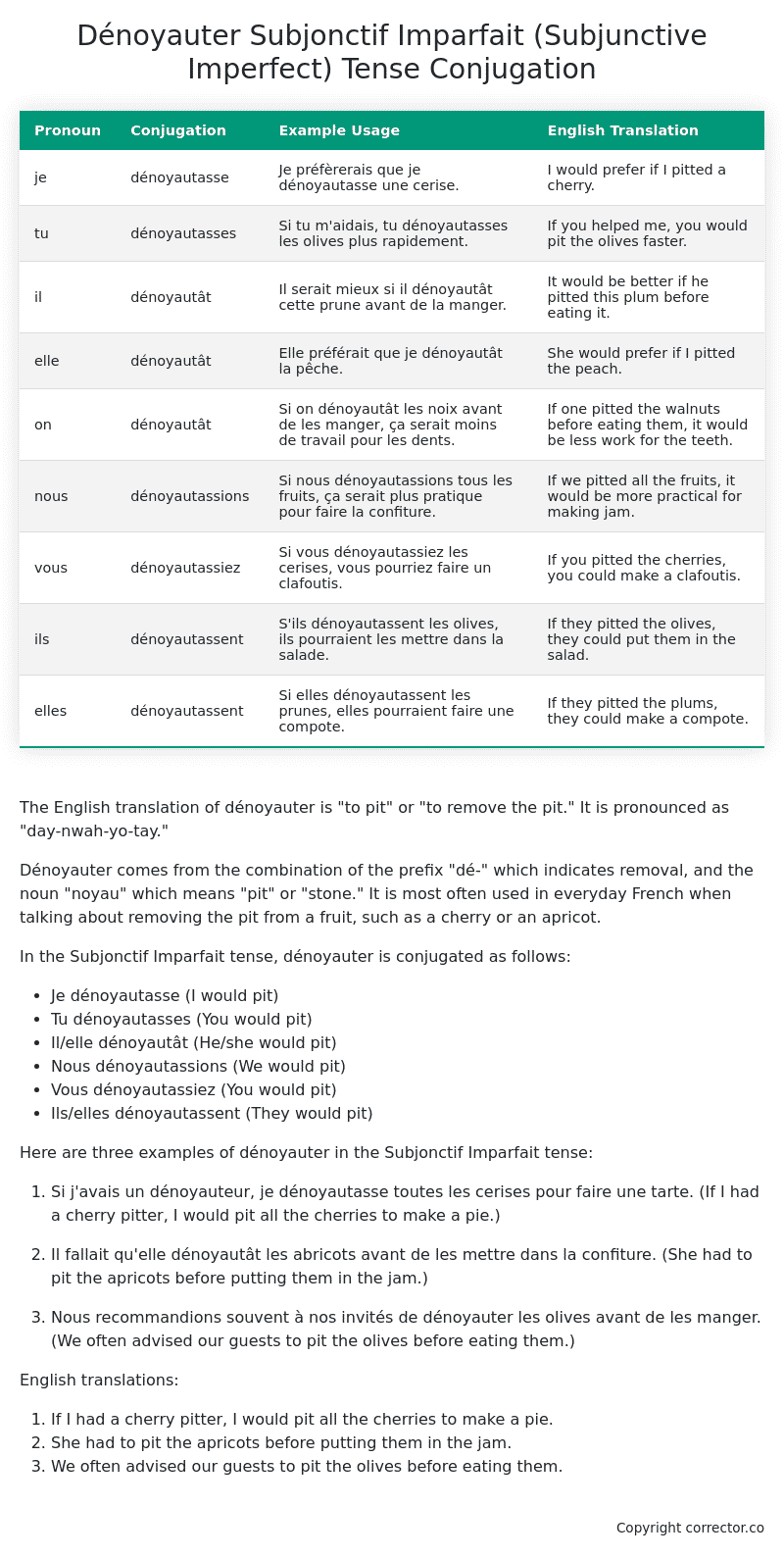Subjonctif Imparfait (Subjunctive Imperfect) Tense Conjugation of the French Verb dénoyauter
Introduction to the verb dénoyauter
The English translation of dénoyauter is “to pit” or “to remove the pit.” It is pronounced as “day-nwah-yo-tay.”
Dénoyauter comes from the combination of the prefix “dé-” which indicates removal, and the noun “noyau” which means “pit” or “stone.” It is most often used in everyday French when talking about removing the pit from a fruit, such as a cherry or an apricot.
In the Subjonctif Imparfait tense, dénoyauter is conjugated as follows:
- Je dénoyautasse (I would pit)
- Tu dénoyautasses (You would pit)
- Il/elle dénoyautât (He/she would pit)
- Nous dénoyautassions (We would pit)
- Vous dénoyautassiez (You would pit)
- Ils/elles dénoyautassent (They would pit)
Here are three examples of dénoyauter in the Subjonctif Imparfait tense:
-
Si j’avais un dénoyauteur, je dénoyautasse toutes les cerises pour faire une tarte. (If I had a cherry pitter, I would pit all the cherries to make a pie.)
-
Il fallait qu’elle dénoyautât les abricots avant de les mettre dans la confiture. (She had to pit the apricots before putting them in the jam.)
-
Nous recommandions souvent à nos invités de dénoyauter les olives avant de les manger. (We often advised our guests to pit the olives before eating them.)
English translations:
- If I had a cherry pitter, I would pit all the cherries to make a pie.
- She had to pit the apricots before putting them in the jam.
- We often advised our guests to pit the olives before eating them.
Table of the Subjonctif Imparfait (Subjunctive Imperfect) Tense Conjugation of dénoyauter
| Pronoun | Conjugation | Example Usage | English Translation |
|---|---|---|---|
| je | dénoyautasse | Je préfèrerais que je dénoyautasse une cerise. | I would prefer if I pitted a cherry. |
| tu | dénoyautasses | Si tu m’aidais, tu dénoyautasses les olives plus rapidement. | If you helped me, you would pit the olives faster. |
| il | dénoyautât | Il serait mieux si il dénoyautât cette prune avant de la manger. | It would be better if he pitted this plum before eating it. |
| elle | dénoyautât | Elle préférait que je dénoyautât la pêche. | She would prefer if I pitted the peach. |
| on | dénoyautât | Si on dénoyautât les noix avant de les manger, ça serait moins de travail pour les dents. | If one pitted the walnuts before eating them, it would be less work for the teeth. |
| nous | dénoyautassions | Si nous dénoyautassions tous les fruits, ça serait plus pratique pour faire la confiture. | If we pitted all the fruits, it would be more practical for making jam. |
| vous | dénoyautassiez | Si vous dénoyautassiez les cerises, vous pourriez faire un clafoutis. | If you pitted the cherries, you could make a clafoutis. |
| ils | dénoyautassent | S’ils dénoyautassent les olives, ils pourraient les mettre dans la salade. | If they pitted the olives, they could put them in the salad. |
| elles | dénoyautassent | Si elles dénoyautassent les prunes, elles pourraient faire une compote. | If they pitted the plums, they could make a compote. |
Other Conjugations for Dénoyauter.
Le Present (Present Tense) Conjugation of the French Verb dénoyauter
Imparfait (Imperfect) Tense Conjugation of the French Verb dénoyauter
Passé Simple (Simple Past) Tense Conjugation of the French Verb dénoyauter
Passé Composé (Present Perfect) Tense Conjugation of the French Verb dénoyauter
Futur Simple (Simple Future) Tense Conjugation of the French Verb dénoyauter
Futur Proche (Near Future) Tense Conjugation of the French Verb dénoyauter
Plus-que-parfait (Pluperfect) Tense Conjugation of the French Verb dénoyauter
Passé Antérieur (Past Anterior) Tense Conjugation of the French Verb dénoyauter
Futur Antérieur (Future Anterior) Tense Conjugation of the French Verb dénoyauter
Subjonctif Présent (Subjunctive Present) Tense Conjugation of the French Verb dénoyauter
Subjonctif Passé (Subjunctive Past) Tense Conjugation of the French Verb dénoyauter
Subjonctif Imparfait (Subjunctive Imperfect) Tense Conjugation of the French Verb dénoyauter (this article)
Subjonctif Plus-que-parfait (Subjunctive Pluperfect) Tense Conjugation of the French Verb dénoyauter
Conditionnel Présent (Conditional Present) Tense Conjugation of the French Verb dénoyauter
Conditionnel Passé (Conditional Past) Tense Conjugation of the French Verb dénoyauter
L’impératif Présent (Imperative Present) Tense Conjugation of the French Verb dénoyauter
L’infinitif Présent (Infinitive Present) Tense Conjugation of the French Verb dénoyauter
Struggling with French verbs or the language in general? Why not use our free French Grammar Checker – no registration required!
Get a FREE Download Study Sheet of this Conjugation 🔥
Simply right click the image below, click “save image” and get your free reference for the dénoyauter Subjonctif Imparfait tense conjugation!

Dénoyauter – About the French Subjonctif Imparfait (Subjunctive Imperfect) Tense
Formation
Common Everyday Usage Patterns
Interactions with Other Tenses
Subjonctif Présent
Indicatif Passé Composé
Conditional
Conditional Perfect
Summary
I hope you enjoyed this article on the verb dénoyauter. Still in a learning mood? Check out another TOTALLY random French verb conjugation!


